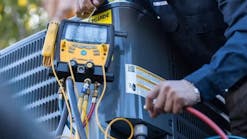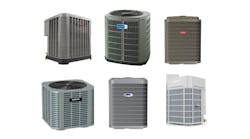by Kenton Pass
In my part of the country, the Front Range area of Colorado, hydronic radiant floor heating is enjoying a huge surge in popularity, especially in the custom-home market. As a residential building contractor specializing in fine new homes and high-end remodeling, I have experienced some unique challenges in the installation of floor heating, both surface mounted and under-floor mounted.
Under-floor mounted
In my opinion, the only time I would ever consider installing an under-floor system would be in a retrofit, remodeling situation. Otherwise, the potential for premature system failure and unhappy customers is too great.
Specifically, we’ve had noise problems generated from the contraction and expansion of the tubing resonating through the sub-floor. Other problems include sagging created by tubing not being properly supported between staples, and a much higher temperature of water needed to maintain an even heat.
These and other problems can contribute to a higher stress level on the tubing and boiler, leading to the dreaded warranty call.
Surface mounted
Obviously, a surface-mount system of tubing stapled to the sub-floor and encased in lightweight concrete is easier to install and much more efficient in heating output.
So, the system is great, but competent individuals to install it can be hard to find, especially in the residential arena. Even when the subcontractor of record is experienced and trained, the people doing the actual hands-on work may not have a clue. Here are a few classic examples ofsurface-mounted problems we’ve encountered over the years:
- On interior layouts, tubing too close to the walls will invite a puncture from carpet tack strips.
- On slab-on-grade applications, decide beforehand who is responsible for laying out the wire mesh, and then CHECK IT. Too often, workers will roll out the wire off square, leave it crooked and barely tie their overlaps together. What a difference a clean wire job makes — the tube runs are straight, everything is secure and the HVAC crew doesn’t threaten to walk off the job.
- Also, the vertical height placement of the tubing in the concrete can determine response time as well as evenness of heat. Is your client building a warehouse with a 6-in. thick slab, and he doesn’t care about response time? Or maybe your project is a custom home with a sensitive homeowner who wants to feel the heat now! Give some thought to where the tubing will lie in the concrete and avoid future problems.
- One more thought about laying tube: Don’t let anyone smoke during the process. A carelessly dropped cigarette butt can roll against the tube, melting a nice, neat hole in your system. Then try finding someone to back charge for that little oversight.
- How many times have you started pouring the mud with the best intentions of being there through the whole process? Did you take off and ask your flatwork sub to watch the pressure gauge for you? Do you invite the fox into your henhouse?
- The most important thing you can do — no, have to do — is watch the pressure gauge while your precious tubing layout is kicked, rolled on, and abused. Tubing these days is pretty darn tough, but with a little determination, even the most careful sub can ruin it.
- Are you pumping or wheel barrowing? In my experience, pumping is quicker and safer, but not always feasible. Small jobs, remodels, bad access -- there are many reasons you may have to move the mud with a wheelbarrow. Now, you really better watch the pressure gauge.
- Try to set up some elevated ramps over the tubing (just make sure the wheelbarrow driver doesn’t run off the side and drop the whole thing on your system). And be aware of the metal brace on the front of the wheelbarrow when a load is dumped — it can crimp a tube faster than you can say lawsuit.
- Also, watch the guy with the shovel or rake. He isn’t thinking about the tubing; he is there to spread mud! Don’t let him go around chopping the concrete with his weapons of destruction.
- An interesting failure happened to a friend of mine, Charlie Hensley, an HVAC consultant in Colorado Springs, Colo. Although he eventually located the tube break, he was at a loss as to why it had occurred. Finally, after several interviews with guys who had worked in the general area of the breakage, it was discovered that one crew had used a “salamander” to heat the room.
The crew had built a deflector to direct the heat down on the floor and away from blowing in their faces. The constant high heat had actually melted the tubing encased in the concrete. You just never know.
Final thoughts
Who is going to run the thermostat wiring — the electrician or the HVAC sub? Make it clear on their scopes of work so you don’t end up fishing wire through the walls.
And where are your thermostats placed? Hopefully not on exterior walls, or where the hot sun shines on the wall, or in a drafty area.
Give critical thought to where you want the manifolds located. We try to find an interior closet wall or other accessible place that won’t be covered by a heavy piece of furniture. And although you will be putting a removable cover over the manifold, take photos of the area before covering and give them to your clients. They might appreciate it down the road when trying to remember where everything is.
In my opinion, hydronic radiant floor heating system is the way to go. Obviously, it takes a good contractor with caring, well-trained subs to make a successful, headache-free installation. n
Kenton Pass, is president of Sawhorse Company, Colorado Springs, CO, a residential building and remodeling contractor. He can be reached at 719/328-1212 or via e-mail at [email protected].








